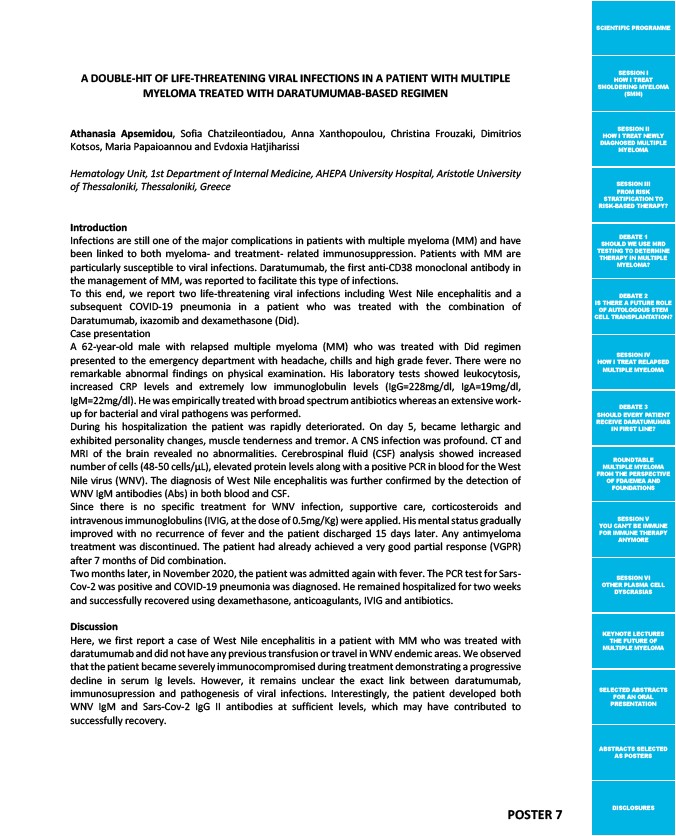
SCIENTIFIC PROGRAMME
SESSION I
HOW I TREAT
SMOLDERING MYELOMA
(SMM)
SESSION II
HOW I TREAT NEWLY
DIAGNOSED MULTIPLE
MYELOMA
SESSION III
FROM RISK
STRATIFICATION TO
RISK-BASED THERAPY?
DEBATE 1
SHOULD WE USE MRD
TESTING TO DETERMINE
THERAPY IN MULTIPLE
MYELOMA?
DEBATE 2
IS THERE A FUTURE ROLE
OF AUTOLOGOUS STEM
CELL TRANSPLANTATION?
SESSION IV
HOW I TREAT RELAPSED
MULTIPLE MYELOMA
DEBATE 3
SHOULD EVERY PATIENT
RECEIVE DARATUMUMAB
IN FIRST LINE?
ROUNDTABLE
MULTIPLE MYELOMA
FROM THE PERSPECTIVE
OF FDA/EMEA AND
FOUNDATIONS
SESSION V
YOU CAN’T BE IMMUNE
FOR IMMUNE THERAPY
ANYMORE
SESSION VI
OTHER PLASMA CELL
DYSCRASIAS
KEYNOTE LECTURES
THE FUTURE OF
MULTIPLE MYELOMA
SELECTED ABSTRACTS
FOR AN ORAL
PRESENTATION
ABSTRACTS SELECTED
AS POSTERS
A DOUBLE-HIT OF LIFE-THREATENING VIRAL INFECTIONS IN A PATIENT WITH MULTIPLE
DISCLOSURES POSTER 7
MYELOMA TREATED WITH DARATUMUMAB-BASED REGIMEN
Athanasia Apsemidou, Sofia Chatzileontiadou, Anna Xanthopoulou, Christina Frouzaki, Dimitrios
Kotsos, Maria Papaioannou and Evdoxia Hatjiharissi
Hematology Unit, 1st Department of Internal Medicine, AHEPA University Hospital, Aristotle University
of Thessaloniki, Thessaloniki, Greece
Introduction
Infections are still one of the major complications in patients with multiple myeloma (MM) and have
been linked to both myeloma- and treatment- related immunosuppression. Patients with MM are
particularly susceptible to viral infections. Daratumumab, the first anti-CD38 monoclonal antibody in
the management of MM, was reported to facilitate this type of infections.
To this end, we report two life-threatening viral infections including West Nile encephalitis and a
subsequent COVID-19 pneumonia in a patient who was treated with the combination of
Daratumumab, ixazomib and dexamethasone (Did).
Case presentation
A 62-year-old male with relapsed multiple myeloma (MM) who was treated with Did regimen
presented to the emergency department with headache, chills and high grade fever. There were no
remarkable abnormal findings on physical examination. His laboratory tests showed leukocytosis,
increased CRP levels and extremely low immunoglobulin levels (IgG=228mg/dl, IgA=19mg/dl,
IgM=22mg/dl). He was empirically treated with broad spectrum antibiotics whereas an extensive work-up
for bacterial and viral pathogens was performed.
During his hospitalization the patient was rapidly deteriorated. On day 5, became lethargic and
exhibited personality changes, muscle tenderness and tremor. A CNS infection was profound. CT and
MRI of the brain revealed no abnormalities. Cerebrospinal fluid (CSF) analysis showed increased
number of cells (48-50 cells/μL), elevated protein levels along with a positive PCR in blood for the West
Nile virus (WNV). The diagnosis of West Nile encephalitis was further confirmed by the detection of
WNV IgM antibodies (Abs) in both blood and CSF.
Since there is no specific treatment for WNV infection, supportive care, corticosteroids and
intravenous immunoglobulins (IVIG, at the dose of 0.5mg/Kg) were applied. His mental status gradually
improved with no recurrence of fever and the patient discharged 15 days later. Any antimyeloma
treatment was discontinued. The patient had already achieved a very good partial response (VGPR)
after 7 months of Did combination.
Two months later, in November 2020, the patient was admitted again with fever. The PCR test for Sars-
Cov-2 was positive and COVID-19 pneumonia was diagnosed. He remained hospitalized for two weeks
and successfully recovered using dexamethasone, anticoagulants, IVIG and antibiotics.
Discussion
Here, we first report a case of West Nile encephalitis in a patient with MM who was treated with
daratumumab and did not have any previous transfusion or travel in WNV endemic areas. We observed
that the patient became severely immunocompromised during treatment demonstrating a progressive
decline in serum Ig levels. However, it remains unclear the exact link between daratumumab,
immunosupression and pathogenesis of viral infections. Interestingly, the patient developed both
WNV IgM and Sars-Cov-2 IgG II antibodies at sufficient levels, which may have contributed to
successfully recovery.